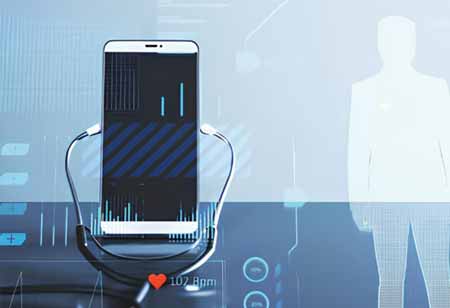Thank you for Subscribing to Healthcare Business Review Weekly Brief
Be first to read the latest tech news, Industry Leader's Insights, and CIO interviews of medium and large enterprises exclusively from Healthcare Business Review
Telemedicine Bridges Healthcare Gaps With Smart Technology
Telemedicine enhances healthcare through virtual consultations, remote monitoring, and AI, improving access and efficiency for patients and providers alike.

By
Healthcare Business Review | Friday, September 26, 2025
Stay ahead of the industry with exclusive feature stories on the top companies, expert insights and the latest news delivered straight to your inbox. Subscribe today.
Telemedicine services are redefining healthcare delivery, bridging access, quality, and efficiency gaps across diverse patient populations. What began as a supplemental care option is now a central component of modern healthcare systems. Enabled by advances in digital communication, artificial intelligence, and remote monitoring technologies, telemedicine is meeting the growing demand for timely, patient-centered care. These virtual services, from regular checkups to chronic disease management and mental health consultations, reshape clinical workflows and enable more responsive, connected, and personalized healthcare experiences.
Expanding Access And Shaping Patient Engagement
Telemedicine services are transforming healthcare by expanding access to medical care beyond traditional clinical settings. The growing demand for convenient, cost-effective, and timely healthcare has accelerated the adoption of virtual consultation models across various regions and specialties. Digital platforms supporting video conferencing, remote diagnostics, and virtual follow-ups are central to modern healthcare delivery. This growth is driven by increasing internet penetration, smartphone accessibility, and evolving patient expectations for on-demand services.
Healthcare providers are leveraging telemedicine to address various needs, from primary care consultations and chronic disease management to mental health support and post-operative monitoring. These platforms enable real-time interactions between patients and clinicians and facilitate continuity of care through electronic health records, prescription integration, and AI-enabled triage tools. The rise of remote patient monitoring technologies and wearable devices allows clinicians to track vital signs and treatment outcomes without requiring physical visits. As a result, telemedicine is reshaping patient engagement and enhancing overall healthcare system efficiency.
Navigating Structural And Technological Barriers
Despite its growing relevance, telemedicine services continue to face several implementation challenges. One of the most persistent issues involves disparities in digital infrastructure. In regions with limited broadband access or low digital literacy, the delivery of remote healthcare services remains inconsistent. To mitigate this, healthcare systems are adopting low-bandwidth platforms, mobile-first solutions, and multilingual user interfaces. These technologies ensure that patients in underserved areas can access care using basic devices or limited connectivity while maintaining quality standards.
Another challenge is integrating telemedicine platforms into existing healthcare workflows. Many providers operate with legacy systems that lack interoperability, making it difficult to synchronize virtual visits with in-person care, diagnostic records, or billing systems. Modular integration solutions and health information exchange standards are being implemented to allow seamless data flow across platforms. These measures support clinical decision-making and reduce administrative burden, promoting greater provider adoption.
Regulatory complexity also poses obstacles to telemedicine expansion. Licensing requirements, reimbursement policies, and data privacy laws vary across jurisdictions, often leading to uncertainty and operational delays. To address this, policymakers are streamlining frameworks that enable cross-border care delivery, while telemedicine providers are incorporating compliance features such as consent management, data encryption, and secure authentication into their platforms. This alignment ensures that virtual care is delivered ethically and in accordance with legal standards.
Clinical appropriateness remains a concern for certain types of care. Not all medical conditions can be precisely analyzed or treated through virtual interaction alone. Hybrid models of care are being introduced to overcome this limitation, allowing patients to begin with a virtual consultation and transition to in-person visits when needed. This flexibility enhances clinical outcomes while preserving the convenience and scalability of remote services.
Provider acceptance and user trust are equally critical. Some healthcare professionals may hesitate to embrace digital care due to concerns over technology reliability or diminished patient relationships. Training programs focused on telemedicine best practices, virtual bedside manners, and platform navigation are helping bridge this gap. Patient education initiatives also build trust and encourage engagement, emphasizing safety, confidentiality, and accessibility in virtual interactions.
Unlocking Value Through Innovation And Collaboration
The telemedicine sector is witnessing rapid technological advancement and strategic expansion, creating significant value for stakeholders across the healthcare ecosystem. Integrating artificial intelligence and machine learning into telemedicine platforms is one of the most transformative developments. AI enhances virtual diagnostics, automates administrative tasks, and personalizes patient pathways. Predictive analytics tools are used to identify high-risk patients, recommend treatment adjustments, and monitor compliance in chronic disease management.
Remote patient monitoring is another key area of growth. Devices that track heart rate, glucose levels, oxygen saturation, and other health metrics allow clinicians to provide proactive care from a distance. These tools reduce hospital admissions, improve patient outcomes, and enable real-time adjustments to treatment plans. Integration with telemedicine platforms also supports data visualization and alert mechanisms, making remote monitoring practical and scalable.
Mobile health applications are expanding the reach of telemedicine services, particularly among younger and tech-savvy populations. These apps allow users to book consultations, access medical records, receive medication reminders, and track symptoms, all from a single interface. Mobile platforms’ convenience and accessibility make them a preferred channel for preventive care, behavioral health support, and chronic disease engagement.
Telemedicine platforms that facilitate multi-specialty consultations and care coordination are strengthening interdisciplinary collaboration. Virtual case conferences, e-referrals, and shared decision-making environments enable providers to deliver more holistic, patient-centered care. This collaborative approach improves diagnostic accuracy and treatment outcomes while reducing delays caused by fragmented care pathways.
The role of telemedicine in enhancing emergency and rural care is particularly notable. In areas with limited access to specialists, virtual consultations can support frontline healthcare providers in real time, offering diagnostic insights and treatment guidance. Tele-triage systems are helping prioritize patient needs and reduce unnecessary emergency department visits, optimizing resource utilization across health systems.






